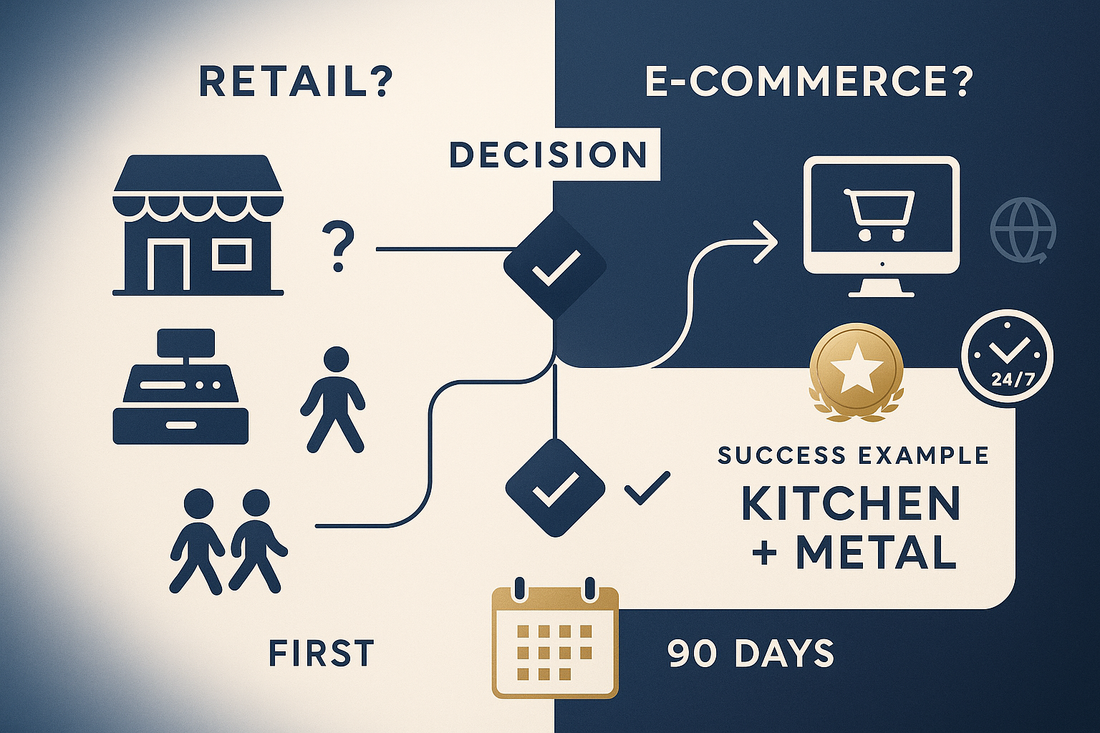
Is an Ecommerce Store the Right Option for You? A Comprehensive Guide to Success in the Digital Marketplace | Kitchen + Metal
Share
Is an Ecommerce Store the Right Option for You? A Comprehensive Guide to Success in the Digital Marketplace

Introduction: The Digital Commerce Revolution
The question isn't whether ecommerce is growing—it's whether you're ready to be part of that growth. With global ecommerce sales continuing to surge and consumer behavior permanently shifted toward online shopping, the opportunity has never been greater. But like any significant business decision, opening an ecommerce store requires careful consideration of your goals, resources, and market position.
Chapter 1: Understanding the Ecommerce Landscape
What Makes Ecommerce Attractive?
Ecommerce offers unprecedented opportunities for businesses of all sizes. When customers can't shop for your products in-person, selling online gives your customers another way to purchase products and engage with your business. It also lets you provide customers with more information about your business, a place for them to leave reviews, and a way for them to sign up for emails from your business.
The Fundamental Question: Is Ecommerce Right for You?
Before diving into setup and strategy, it's important to understand your goals. Ask yourself basic questions about your store: Do you want to sell your products both online and in person? Do you want to sell through social media channels like Facebook? This can help you focus your attention and speed up your setup process.
Chapter 2: Weighing the Pros and Cons
The Advantages of Ecommerce
1. Low Barrier to Entry Starting an ecommerce business typically requires lower upfront costs compared to traditional retail. There are no costs associated with physical retail space, and you can focus your efforts on marketing and creating a good buying experience for your customers.
2. Global Reach Unlike physical stores limited by geography, ecommerce allows you to reach customers worldwide, dramatically expanding your potential market.
3. 24/7 Operations Your store never closes, allowing customers to shop at their convenience and generating revenue around the clock.
4. Data-Driven Insights Digital platforms provide detailed analytics about customer behavior, allowing you to make informed decisions about inventory, marketing, and customer service.
5. Scalability Ecommerce businesses can scale more easily than traditional retail, as you're not constrained by physical space limitations.
The Challenges to Consider
1. Increased Competition The low barrier to entry means more competition. When you have more competition, you receive fewer orders and often need to lower your prices to remain competitive.
2. Digital Marketing Requirements Success requires understanding digital marketing, SEO, social media, and online advertising—skills that may require investment in learning or hiring expertise.
3. Customer Service Complexity Managing online customer service, returns, and shipping issues requires different skills than face-to-face retail.
4. Technology Dependence Your business relies on technology infrastructure, requiring ongoing maintenance and updates.
Chapter 3: The Critical First 90 Days
Setting the Foundation (Days 1-30)
Week 1-2: Business Setup
- Register your business if necessary, though you can explore selling online without registering your business initially
- Open a separate business bank account
- Choose which sales channels you want to use
- Set up your domain to ensure customers can find your store online
Week 3-4: Store Configuration
- Add your first product to test the system
- Choose a theme that reflects your brand
- Set up payment gateways and shipping settings
- Configure your business address and tax settings
Building Momentum (Days 31-60)
Product Strategy Focus on a curated selection rather than overwhelming customers. In most cases, it's better to have a focus, or a niche, for the types of products you choose to sell.
Content Creation
- Write engaging product descriptions that are clear and scannable
- Use high-quality product images
- Create essential pages (About Us, Shipping Policy, Return Policy)
Marketing Launch
- Set up email marketing
- Begin social media presence
- Consider paid advertising for initial traffic
Optimization and Growth (Days 61-90)
Performance Monitoring Define metrics to track on your product pages to understand if your product descriptions are leading to more sales. Common metrics include:
- Conversion rate
- Cart abandonment rate
- Return rate
- Support inquiries
- Organic search rankings
Customer Feedback Integration Use customer reviews and feedback to refine your product offerings and improve the shopping experience.
Chapter 4: Success Metrics and Measurement
Key Performance Indicators (KPIs) to Track
Financial Metrics
- Total sales and revenue growth
- Average order value
- Customer acquisition cost
- Profit margins
Operational Metrics
- Conversion rates
- Website traffic and sources
- Customer retention rate
- Inventory turnover
Customer Experience Metrics
- Customer satisfaction scores
- Return and refund rates
- Support ticket resolution time
Setting Realistic Expectations
Success in ecommerce rarely happens overnight. The first 90 days are about establishing systems, learning your market, and building initial momentum. Many successful stores see gradual growth over their first year as they refine their approach based on real customer data.
Chapter 5: The Kitchen + Metal Success Story
A Case Study in Ecommerce Excellence
Kitchen + Metal represents an excellent example of how focused ecommerce strategy can build a successful business. While specific performance metrics are proprietary, the store demonstrates several key success factors:
1. Clear Brand Identity The name "Kitchen + Metal" immediately communicates the product focus, making it easy for customers to understand what the store offers.
2. Niche Focus Rather than trying to be everything to everyone, Kitchen + Metal appears to focus on a specific market segment, allowing for targeted marketing and customer service.
3. Professional Presentation The store maintains a professional online presence that builds customer trust and confidence.
Lessons from Kitchen + Metal's Approach
Strategic Domain Choice Using kitchenandmetal.com creates a memorable, brandable web address that's easy for customers to remember and type.
Market Positioning By focusing on kitchen and metal products, the store can become an authority in its niche rather than competing in oversaturated general markets.
Chapter 6: Making Your Decision
When Ecommerce Makes Sense
Consider ecommerce if you:
- Have products that can be effectively sold online
- Want to reach customers beyond your local area
- Can invest time in learning digital marketing
- Have reliable internet and basic technical skills
- Can handle shipping and logistics
When to Proceed with Caution
Reconsider if you:
- Sell products requiring extensive in-person consultation
- Lack time for ongoing store management
- Have extremely limited startup capital
- Cannot handle the technical aspects or afford professional help
Alternative Approaches
Hybrid Model Consider combining online and offline sales channels. Many successful businesses use ecommerce to complement existing physical operations.
Marketplace Starting Point Begin selling on established marketplaces (Amazon, eBay, Etsy) before launching your own store to test market demand with lower risk.
Chapter 7: Getting Started - Your Action Plan
Immediate Steps (This Week)
- Research Your Market: Analyze competitors and identify your unique value proposition
- Choose Your Platform: Shopify offers comprehensive tools for businesses of all sizes
- Plan Your Budget: Account for platform fees, marketing, and initial inventory
- Start Small: Begin with a focused product line rather than trying to offer everything
First Month Goals
- Complete Store Setup: Get your basic store operational with essential pages and policies
- Add Initial Products: Start with 5-10 products to test the market
- Set Up Analytics: Implement tracking to measure your progress from day one
- Plan Marketing Strategy: Develop a 90-day marketing calendar
Building for Long-Term Success
Continuous Learning Ecommerce evolves rapidly. Stay informed about new features, marketing strategies, and industry trends.
Customer-Centric Approach Always prioritize customer experience. Happy customers become repeat buyers and brand advocates.
Data-Driven Decisions Use analytics to guide your decisions rather than relying on assumptions.
Conclusion: Your Ecommerce Journey Starts Now
Opening an ecommerce store can be one of the most rewarding business decisions you make, but success requires preparation, dedication, and realistic expectations. The digital marketplace offers unprecedented opportunities for businesses willing to invest in learning and adapting.
Kitchen + Metal's success demonstrates that with the right approach, focus, and execution, ecommerce can build a thriving business. The key is starting with a clear vision, maintaining focus on your niche, and continuously optimizing based on customer feedback and performance data.
The question isn't whether ecommerce is right for everyone—it's whether you're ready to commit to the journey. If you have products people want, the willingness to learn, and the persistence to build something meaningful, ecommerce could be the perfect vehicle for your entrepreneurial ambitions.
Remember: every successful ecommerce store started with someone asking the same question you're asking now. The difference between those who succeed and those who don't isn't just the idea—it's the execution and commitment to continuous improvement.
Your ecommerce journey can start today. The tools, knowledge, and opportunities are all available. The only question remaining is: are you ready to take the first step?

